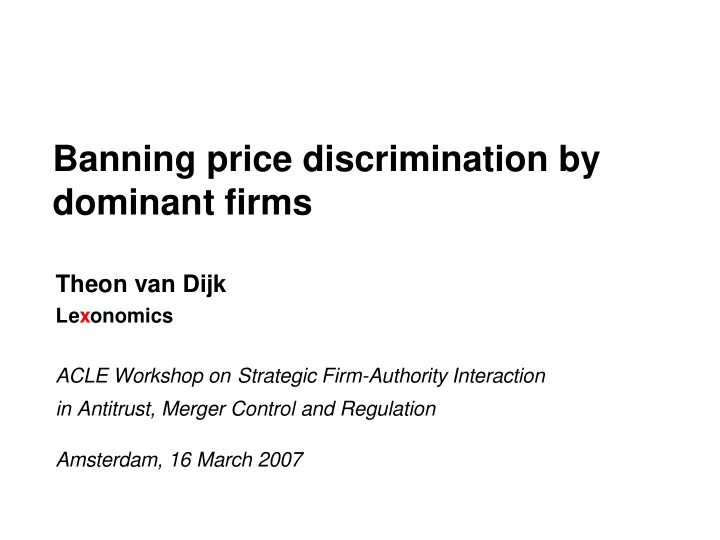

Banning price discrimination by dominant firms Theon van Dijk Lexonomics ACLE Workshop on Strategic Firm-Authority Interaction in Antitrust, Merger Control and Regulation Amsterdam, 16 March 2007
Amsterdam, 16 March 2007 Background • “Banning Price Discrimination by Dominant Firms” with Jan Bouckaert (University of Antwerp) and Hans Degryse (Tilburg University), working paper, February 2007 • “Dominant” firms • Working paper analyses two price discrimination bans for dominant firms: 1. Ban on “higher-prices-to-sheltered-consumers” 2. Ban on “lower-prices-to-rival’s-customers” ? focus today 2
Amsterdam, 16 March 2007 Motivation: cases in regulation and antitrust • Restrictions on former monopolist in liberalised sectors to “win back” customers that switched to competitors - Eg. uniform rate requirements for cable operators in the US in order “to prevent cable operators from dropping the rates in one portion of a franchise area to undercut a competitor temporarily” • “Selective price cutting” targeted at customers of competitors can be an abuse of dominance under Article 82 of EC Treaty - Eg. AKZO; Irish Sugar; Compagnie Maritime Belge; Hilti - Prices above marginal costs ? no predatory pricing - Not illegal in the US ( Brooke; American Airlines ) 3
Amsterdam, 16 March 2007 Economic intuition • Prohibiting targeted response by dominant firm encourages entry or prevents exit • More “costly” for dominant firm to respond to entry with lower prices because of lost revenues of infra-marginal consumers ? relaxes competition: dominant’s firm prices are higher without targeted response • Higher prices imply more scope for entry 4
Amsterdam, 16 March 2007 Modelling framework • Two segments and two asymmetric firms - Sheltered segment with dominant firm (firm A) � Dominant firm’s overall market share > 50% - Competitive segment with dominant and non-dominant firm (firm B) � Competition on competitive segment à la Hotelling • Two periods - Period 1 : each firm charges uniform prices on the competitive segment - Period 2 : different prices to own customers and rival’s customers (“poaching” or “behavior-based price discrimination”) • All consumers buy each period (repeated sales) 5
Amsterdam, 16 March 2007 Interpretation of model • Covers following scenarios: - Former monopolist faces entry only in liberalised segment (period 1) and responds selectively to entrant (period 2) - Dominant firm faces competitive threat in part of the market (eg. only business customers or only at geographical border) and responds selectively to that threat • Ban on “lower-prices-to-rival’s-customers”: - Firm A is known to be dominant in period 2 - Dominant firm A has to charge a uniform price in the competitive segment in period 2 (same price to own and rival’s customers – no selective price cutting) - In period 1 both firms anticipate the ban for the dominant firm in period 2 6
Amsterdam, 16 March 2007 First period without ban A B A w ( ) ( ) + δ + δ = t 3 = t 3 p B A p 1 1 3 3 0 x 1 A ’s sheltered segment B A competitive segment 7
Amsterdam, 16 March 2007 Second period without ban A w A B p AA = p BB = 2 t 2 t 2 2 3 3 A B p AB = p BA = t t 2 2 3 3 β α 0 x 1 A ’s sheltered segment B A competitive segment 8
Amsterdam, 16 March 2007 Second period with ban (static analysis) w p BB = 3 t ' ' 2 4 p A = t ' ' 2 2 AB = t ' ' p 2 4 α ’’ β ’’ 0 x’’ 1 A ’s sheltered segment B A competitive segment 9
Amsterdam, 16 March 2007 Static analysis • Economic intuition is confirmed in static analysis (only second period) - Competition for B’s customer base relaxes as A poaches less aggressively - Competition for A’s customer base intensifies - Overall prices and profits for B are higher ? ban encourages entry • Thisse & Vives (AER 1988) and Armstrong & Vickers (JIE 1993) have similar results 10
Amsterdam, 16 March 2007 First period with ban w ( ) − δ = t 12 p A ' ' 1 12 ( ) − δ = t 3 p B ' ' 1 3 0 x’’ 1 A ’s sheltered segment B A competitive segment 11
Amsterdam, 16 March 2007 Dynamic analysis • First period is added, in which both firms anticipate the ban for firm A in the second period • This leads to harsher competition in the first period - First-period demand becomes substantially more elastic - Marginal customer becomes more price sensitive in first period � When the dominant firm decreases its first-period price by one unit, the second- period poaching price of the other firm goes up by less than one unit • Harsher competition across both periods - Discounted average prices decrease - Discounted average profit firm B decreases ? ban discourages entry 12
Amsterdam, 16 March 2007 Various effects of the ban With ban Consumer surplus + Discounted average prices - Average transportation costs - Producer surplus - Average first-period prices - Average second-period prices for A’s customer base - Average second-period prices for B’s customer base + Total welfare + 13
Amsterdam, 16 March 2007 Policy discussion: ban or no ban? • Bans on win-back campaigns and selective price cuts by dominant firms are imposed to encourage entry - In static model, ban works by relaxing competition for the entrant • In dynamic model, ban intensifies overall competition - Dominant firm initially competes more aggressively in to create optimal situation when ban becomes effective ? discourages entry ? increases consumer surplus and total welfare • What is the main objective of competition policy? - To increase consumer surplus?; to increase total welfare?; to facilitate the competitive process? 14
Recommend
More recommend